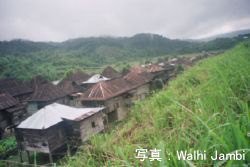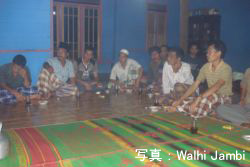Promoting Community Forest for Sustainability Livelihood.
 |
Walhi Jambi | |
 |
Arif Munandar | |
 |
http://walhi-jambi.blogspot.com/ | |
 |
JPY 300,000 |
Research Background Final Report (abstract) Others

living in customary forests

meeting at Lubuk Beringin village
Research Background
The vast of Indonesia's natural forest is rapidly decreasing into a further concern. Until now, Indonesia has already loosing 72 percent of its genuine forest [World Resource Institute, 1997]. For years, uncontrolled trees cutting had caused a massive decrease of the tropical forest in Indonesia. The rapid damage of the forest recorded 1.6 million hectare a years in 1985-1997 period, whereas 3.8 million hectare a years recorded in 1997-2000 period. This is making Indonesia as one of a place with the highest forest damage in the world. In Indonesia according to the result of Land Sat image view in year 2000 there is 101.73 million hectare forest and land was damaged, 59.62 million hectare among those is on the forest area.
With the decrease cover of Indonesia's forest, then most of the area had became susceptible to the disaster, whether dryness, flood or landslide. Since 1998 to mid 2003, 647 disaster occurrences recorded in Indonesia with 2022 victims and billions of rupiah loss, which 85% of the disaster caused by flood and landslide as the result of forest damage.
Jambi is one of the provinces in Indonesia that suffer a forestry problem quite similar to other provinces in Indonesia. According to Jambi's Forestry Department, the vast area of province of Jambi is about 5.100.000 hectare which around 40% of the area is the forest area extend from Kerinci Seblat National Park in the west to Berbak National Park in the east.
According to Executive Director of Warsi, Rachmat Hidayat, in media Info Sumatera (2007), the high of the forest rapid damage is caused by uncontrolled trees cutting for wood industry, illegal logging, people plantation opening, forest for industrial plant developing, forest fire, and large scale palm oil plantation developing.
In the middle of the forest rapid decrease occur in Indonesia generally, and province of Jambi specifically, a small group of people that live in Durian Rambun village, Lubuk Birah village, Lubuk Beringin village, Siau subdistrict, Jambi province, succeed in protecting, preserving, and also taking benefit from the forest in their area in wise and prudent way. So called people customary forest of Durian Rambun, Lubuk Birah, and Lubuk Beringin village are the examples of the successful forest management conducted by the people.
In accordance to that condition, Walhi is interested to look insight the values or arrangement of the people in Durian Rambun, Lubuk Birah, Lubuk Beringin villages in preserving their customary forests.
This research is trying to know how the people of Durian Rambun, Desa Lubuk Birah, Desa Lubuk Beringin villages, preserves their customary forests. To obtain this data, the methods that will be used are: (1) Interview, (2) Observation, and (3) Documentation study (Miles dan Huberman, 1992).
The impact of this research is influential to the directness of forest management system that long practiced by the local people. Todays, the practice of forest management conducted by the people of Durian Rambun, Lubuk Birah, Lubuk Beringin villages is threaten by the plan of Forestry Department that will establish Forest for Industrial Plant (HTI) ranging 350.000 hectare wide in Jambi Province.
The establishment of Forest for Industrial Plant in Jambi province is a nightmare for the farmer people. As an example, PT Wira Karya Sakti is a HTI company which is owns a concession license area ranging 298.812 hectare wide which is situated in 5 regencies had removed more than 20.000 farmers which work on the ex-HPH (Forest concession license) land. Until now, the conflict between farmers and PT WKS has not come up to a clear solution. Besides causing an agrarian conflict with the farmers, the establishment of the Forest for Industrial Plant is also causing other negative impact such as: the loss of biological diversity, flood on rainy season, dryness and fog on dry season.
This research will reveals the truth for the policy maker to reconsider the plan establishment of Forest for Industrial Plant which is potential to destroy forest management system of local people which is been established in a long period of time.
The complete information concerning the arrangement made by people of Durian Rambun, Lubuk Birah, Lubuk Beringin villages in managing and benefiting the customary forest in their area in a prudent way will be used to urge the policy maker in forestry broad in order to acknowledge and to protect the local people's forest management practices.
[January 2009]
Final Report (abstract)
Location
Merangin District is one of nine Districts in Jambi Province. Merangin District area includes inside of the National Park (TNKS) area with total of 121,046 ha, protection forest area of 36,734 ha; production forest of 136,275 ha; Limited production forest of 44,118 ha and other functional area of 129,729 ha. Total area of forest in Merangin District is 767,900 ha.
In Merangin District, 3 companies hold permit of HPH(Forest concession license). The first company is PT. Injapsin Lestari with (decree letter) SK. HPH No. 107/Kpts-IV/88 for 61,610 ha. The second company is PT Sarestra II with SK. HPH No. 845/Kpts-II/81 for 61,805 ha and the third one is PT Nusalease TC with SK. HPH No. 845/Kpts-II/81 for 56.768 hectare. According to the permit of HPH given, it was invalid already, so then the status of the area has turned back to government.
When these three companies operate their business, they did not take into consideration environmental aspects and paid attention to community engagement around the concession area who established its system management on natural resource and There for it would give impact on critical land extension in Merangin district, the broad critical area in Merangin District is 230,121 Ha or 29.96% of total forest area that exist in Merangin district.
The problem that directly felt by community surrounded these forest areas is the threat from illegal logging, smuggling the potential of natural resource in the forest area inside and outside of village as well. Meanwhile other problems in natural resources management are the difficulties to manage the area particularly in manage the spatial function. This is because of less of knowledge about the model of forest management. Management model recently oriented to security and utility (cut the tree without rehabilitate) which become the threat in vanishing the forest sources especially the timber in side the forest area. So then, the research is focused on three villages in Muara Siau Sub-District, Merangin District, Jambi Province, include 1. Village Lubuk Beringin, 2. Lubuk Birah Village, and 3. Durian Rambun Village
Activity
Focus group Discussion/FGD was carried out in 3 villages. This FGD engaged the community leader, youth leader, customary leader, and village institution. This FGD is a follow-up action of informal interview and individual discussion with some contact person. After complete and compile the information, FGD was held on January 20, 2009 at Durian Rambun village on 15 February and march 14, 2009 at Lubuk Biah village ( Desa Lubuk Birah Dan Lubuk Beringin) this FGD is carried out by cooperate with community in this three villages. The discussion started to expose the history, customary, social, economic, and forest management model by the community. Then keep directed to the solution, came from the condition that HPH and HTI concession already exist and threat of forest as well. From FGD which is carried out in that three villagers made community expect that local wisdom and customary law that they have become their strength in keep their forest from threat of expansion and new open land both HPH and HTI also palm oil company. Moreover, community expect that government respects their regulation in manage their forest. The big expectation from community is that government make the regulations that refer to local wisdom and if necessary adopt the customary law that community have in making forest management policy.
Village Meeting
The village meeting was carried one time and attended by communities of Durian Rambun, Lubuk Birah, and Lubuk Beringin. It was carried out after a discussion with community leader in those three villages and then agreed to have one village meeting in Durian Rimbun Village. This meeting was held on march 21st, 2009. This meeting was to reveal and dig information in participative by engaged participants from three villages and this meeting was become a forum to convey some result of researches that already been conducted before. This meeting became so important to confirm all findings which been obtained by researchers. The results of the research will be concluded and then compiling all the findings by the team. All compiling result will be published in book, press release, and other publishing's media.
Expectation of this meeting was in order to all communities understood and starts to respect their own local wisdom. Besides, this research will be reference by Walhi Jambi and local community in dialog and communicate also encourage the policy makers to concern the tradition and local regulation and then adopt them into government policies particularly related with forest management.
Field Observation
From field observation can be found as written bellow:
1. Margo Senggrahan area include ex PT HPH PT INJAPSIN concession, community hope the area can be returned to the community to be managed with their own local wisdom.
2. Since permit HPH PT INJAPSIN was expelled, community never get any beneficiary, their livelihood was vanished because the Margo Senggrahan forest that used to be full with biodiversity and its richness variety of flora was disappeared.
3. Management of margo Senggrahan Forest system is very traditional, the community open the land to rice farming by using traditional equipment and using cooperative working system (gotong royong system).
4. The livelihood of Margo Senggrahan community since years ago is crop growing/rice farming/fielding rice and berikan/sukam.
The Conclusion
Some conclusions from much information that we explore and dig become the recommendation as well for customary forest management and potential threaten to Margo Senggrahan customary forest.
1. To protect the forest need to be carried out an empowerment and education for the Margo Senggrahan Community.
2. there is no integrated policy on forest management based on indigenous people, the policy means the policy that adopt from customary law that still apply in the community.
3. There is no officially acknowledgement by district government to the customary forest of the margo Senggrahan.
4. Autonomy. Radical Autonomic become one of those that community afraid of because it threat the existence of customary forest. many parties want to exploit the forest, besides that economic jargon is expressed in every program of district government wrapped with PAD, so then the government without any consultation and act as it want, giving the concession permit for the logging company and plantation company without think and consider about the existence of Margo Senggrahan community as the owner.
Recommendations
These recommendations were obtained from interviews, discussions, and observation in field, then some recommendation can be concluded as written bellow:
1. The existences of customary forest of the Margo Senggrahan community need to be socialized/informed to many parties wider.
2. Participatory mapping for customary forest area, because community has no map of the customary forest.
3. Encourage the acknowledgement from Merangin District Government on Margo Senggrahan customary forest area.
4. Conduct dialog and lobby to the government especially to Merangin District Government.
5. Establish government commitment to adopt customary regulations into government regulations that relate with forest management.
6. Strengthen the community position with its local wisdom in solving the problems that threat the existence of customary forest.
7. Establish collaboration between communities who lives around Taman Nasional Kerinci Seblat (or National Park of Kerinci Seblat) because now there is village autonomy and it can be the way to strengthen the collaboration to protect the forest area.
Others
